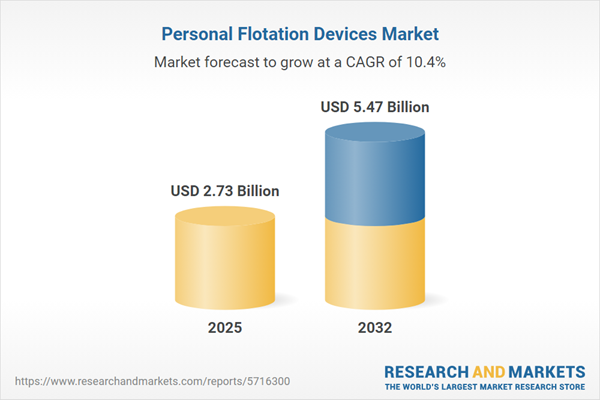Speak directly to the analyst to clarify any post sales queries you may have.
Senior executives seeking actionable insights into the personal flotation devices market will find a rapidly evolving landscape shaped by technological innovation, regulatory change, and shifting global demand. This report provides a strategic overview of industry trends, segment opportunities, and supply chain considerations for informed planning and investment.
Personal Flotation Devices Market Snapshot
The personal flotation devices market is expanding as safety priorities increase and product innovation accelerates. Valued at USD 2.47 billion in 2024, the market is projected to reach USD 2.73 billion in 2025 and climb to USD 5.47 billion by 2032. A compound annual growth rate of 10.41% underscores the robust momentum industry players must address to stay competitive.
Scope & Segmentation
This analysis covers a comprehensive set of market segments, product categories, and regions to provide senior leaders with a complete perspective:
- Device Types: Infant devices, inflatable devices, life jackets, life vests, ring buoys, throwable devices
- End Uses: Commercial (cruise ships, maritime transport, offshore oil and gas), military (army, coast guard, navy), recreational (boating, fishing, water sports), and rescue services (fire and safety, lifeguard)
- Distribution Channels: Direct sales (bulk orders, corporate sales), general retail (department stores, supermarkets), online retail (e-commerce platforms, manufacturer websites), specialty stores (marine outlets, sporting goods stores)
- Material Types: Hybrid material, neoprene, nylon, PE foam, PVC
- Designs: Foam, hybrid, inflatable
- Age Groups: Adult, infant, youth
- Regions: Americas (United States, Canada, Mexico, Brazil, Argentina, Chile, Colombia, Peru), Europe, Middle East & Africa (United Kingdom, Germany, France, Russia, Italy, Spain, Netherlands, Sweden, Poland, Switzerland, United Arab Emirates, Saudi Arabia, Qatar, Turkey, Israel, South Africa, Nigeria, Egypt, Kenya), Asia-Pacific (China, India, Japan, Australia, South Korea, Indonesia, Thailand, Malaysia, Singapore, Taiwan)
- Leading Companies: Survitec Group Ltd, Spinlock Ltd, Mustang Survival Corp, Johnson Outdoors Inc, Zodiac Aerospace SE, West Marine Inc, Helly Hansen AS, Northwest River Supplies Inc, Kokatat Inc, Zhik Pte Ltd
Key Takeaways for Decision-Makers
- Heightened regulatory standards are accelerating development of advanced flotation devices and compelling market participants to adapt quickly.
- Smart safety technologies, including sensor-based connectivity and GPS signaling, are reshaping equipment expectations across both consumer and institutional segments.
- Diversification is critical: Products supporting unique end uses—such as military operations or emerging leisure segments—are capturing new market share.
- Strategic collaborations and acquisitions are intensifying, with leading firms seeking geographic expansion and research partnerships to maintain competitive advantage.
- Regional insights reveal that demand drivers range from stringent maritime safety laws in Europe and North America to infrastructure upgrades and tourism growth in Asia-Pacific and the Middle East.
- Environmental demands and cost-efficiency remain important, with eco-conscious material innovations gaining traction among both established and new market entrants.
Tariff Impact and Supply Chain Considerations
The introduction of new U.S. tariffs in 2025 has added complexities to the personal flotation devices market, impacting raw material costs and reevaluating sourcing strategies. Manufacturers respond by either shifting production closer to end markets or securing long-term domestic contracts. These adjustments underscore the importance of flexible procurement and resilient supply chains as companies navigate ongoing policy uncertainty.
Methodology & Data Sources
This report synthesizes primary interviews with industry experts, safety regulators, and material scientists alongside secondary research from technical publications and trade associations. Data triangulation and scenario modeling provide a reliable foundation for projections and strategic analysis.
Why This Report Matters
- Enables leaders to benchmark evolving product and regulatory trends in the personal flotation devices market for confident investment and planning.
- Supports informed decision-making with segmentation insights, technology roadmaps, and regional demand mapping—all relevant to risk assessment and opportunity identification.
- Empowers supply chain and procurement teams to anticipate tariff-driven disruptions and build operational resilience.
Conclusion
By combining rigorous research with actionable market intelligence, this report equips senior decision-makers with the insights needed to adapt, compete, and grow. Stakeholders can use these findings to drive innovation, secure compliance, and strengthen market position as sector complexity increases.
Additional Product Information:
- Purchase of this report includes 1 year online access with quarterly updates.
- This report can be updated on request. Please contact our Customer Experience team using the Ask a Question widget on our website.
Table of Contents
3. Executive Summary
4. Market Overview
7. Cumulative Impact of Artificial Intelligence 2025
List of Figures
Companies Mentioned
The companies profiled in this Personal Flotation Devices market report include:- Survitec Group Ltd
- Spinlock Ltd
- Mustang Survival Corp
- Johnson Outdoors Inc
- Zodiac Aerospace SE
- West Marine Inc
- Helly Hansen AS
- Northwest River Supplies Inc
- Kokatat Inc
- Zhik Pte Ltd
Table Information
| Report Attribute | Details |
|---|---|
| No. of Pages | 189 |
| Published | October 2025 |
| Forecast Period | 2025 - 2032 |
| Estimated Market Value ( USD | $ 2.73 Billion |
| Forecasted Market Value ( USD | $ 5.47 Billion |
| Compound Annual Growth Rate | 10.4% |
| Regions Covered | Global |
| No. of Companies Mentioned | 11 |









